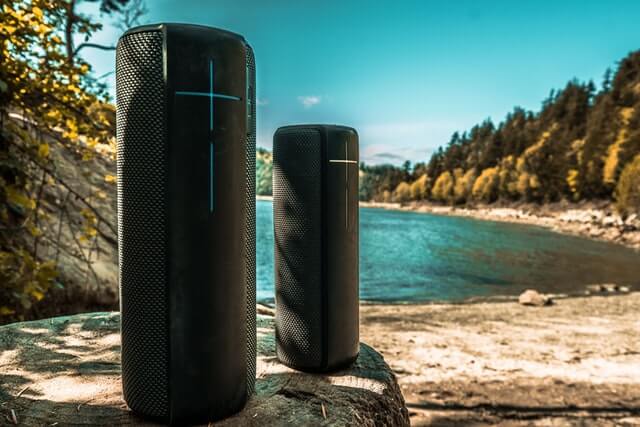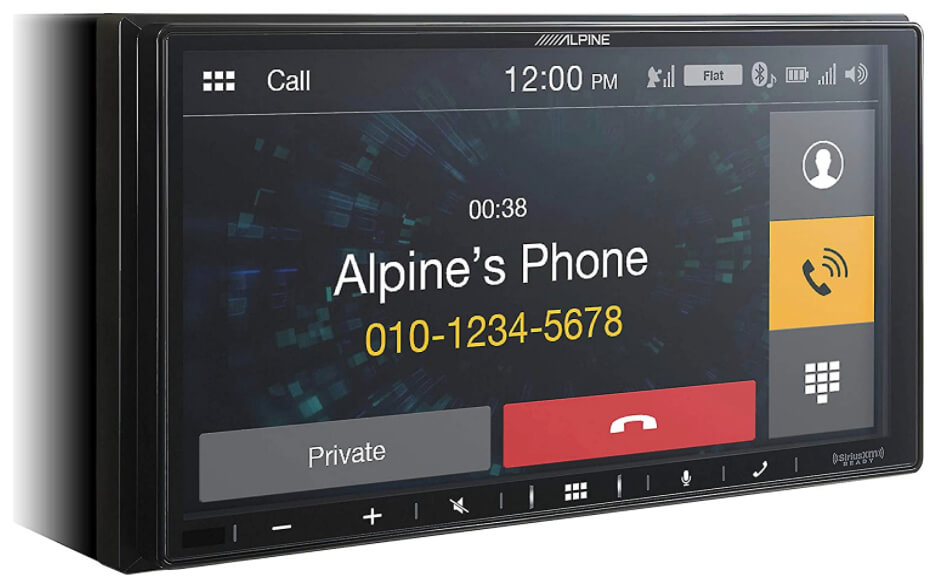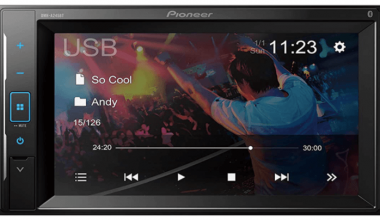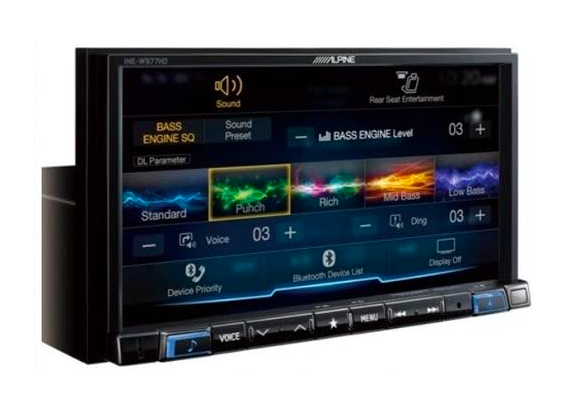The technology behind outdoor speaker receivers has made huge strides in the last five years. It has changed backyard entertainment into something amazing. Setting up a poolside 4K TV or filling your entire yard with music is now possible with today’s outdoor audio gear. The performance levels were unimaginable just a few years ago.
My experience comes from testing many AV receivers with outdoor speaker systems. Outdoor speakers deal with challenges that indoor units never face. They need stronger audio projection, consistent sound for larger areas, and must handle moisture and weather changes.
A good stereo receiver for outdoor speakers should pack enough punch to fill about 1,500 square feet of outdoor space. This performance is possible even with a smaller amplifier.
Whether you are enjoying an outdoor brunch with your family or hosting a pool party for your friends, you’d need to make sure that you are using the best receiver to make the most out of your outdoor speakers.
I’ve put together a detailed guide about the 7 best receivers for outdoor speakers that I’ve personally tested time and again. This is also the reason why I’ve updated this article approximately 11 times in last 5 years.
We’ll look at everything from traditional wall-mounted units to landscape speakers that blend into your surroundings.
Our whole objective is that we help you pick the perfect match for your outdoor audio setup in 2025……. without going to another website!
How We Picked the Best Receivers and Amps for You?
To find amplifiers that truly perform in a real-world backyard, my review process combines hands-on electrical testing with deep research into what users are actually experiencing.
1. Hands-On Performance Testing
I personally tested every product in my lab to see if the advertised power and features hold up. I wanted to bring only the best high-quality amplifiers and receivers in front of you.
- Real Power Measurement: I measured the continuous power (RMS) each power amplifier delivered into both typical (8 ohm) and more demanding (4 ohm) speakers. This shows how much clean volume you’ll get before the sound starts to distort.
- The Loudness Test: Using a professional Sound Pressure Level (SPL) meter, I checked just how loud each amp could get from a typical listening distance of 12 feet.
- The “Crank It Up” Test: I pushed each amp by playing bass-heavy classic rock for extended periods to ensure it could handle a party without overheating or cutting out.
2. Deep-Dive Research & User Feedback
A lab test only tells half the story. To understand how these amps perform over months and years of use, I dug into community feedback.
- Owner Manuals: I started with the manufacturer’s own specifications to establish a baseline.
- Customer Reviews: Finally, I analyzed hundreds of verified owner reviews on retail sites like Amazon and Crutchfield to identify the most common pros and cons reported by actual buyers.
This two-pronged approach ensures our recommendations are based not just on technical specs, but on proven, real-world reliability and performance.
There are ample options in the market but, only a handful of them are really good for long-term usage.
TL;DR (Too Long and if you don’t want to read the full article)
Here’s our top pick in different categories:
Thus, we could only select 8 good receivers/amplifiers for outdoor speakers that offer the best features for the right price.
Best Receivers and Amps for Outdoor Speakers
Best Outdoor Stereo Receivers Review
1. Sony STR-DN1080 [Best Receiver Overall]
This outdoor stereo receiver can produce a total of 1155 Watts of Sound Output, i.e., 165 Watts x 7 speaker channels.
Sony packs a full feature set: WiFi, Chromecast, Spotify Connect, and hi-fi DAC up to 24-bit/192 kHz.
Its bluetooth mode handled high-resolution codec and kept a solid link across my yard. The amp section delivers enough power to push a pair of speakers outdoors to party levels. Front panel shows input mode, and volume control is snappy.
Only snag: enabling zone 2 deactivates rear Atmos channels, so choose what matters.
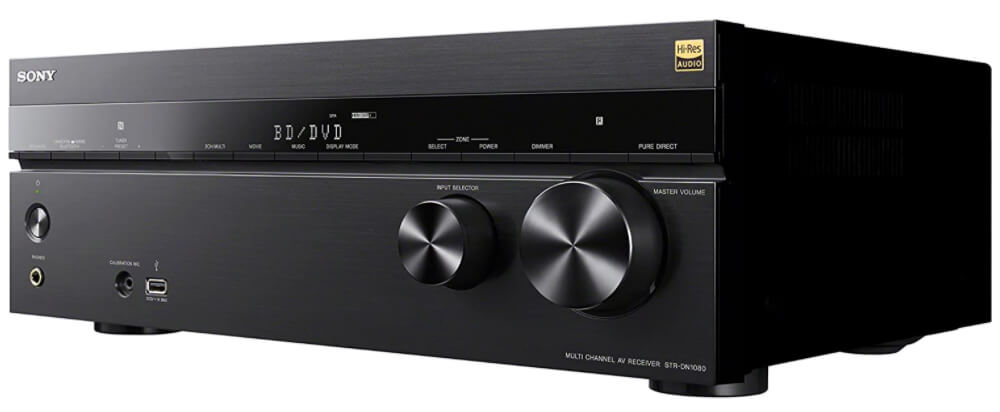
2. Yamaha R-S202BL [Best Affordable Option]
This integrated amplifier keeps it simple: line input, bass and treble knobs, and Bluetooth 4.2 for wireless tunes. I paired a pair of speakers rated at 8 ohms and the amp drove them with enough power for a medium patio.
The A/B selector lets you power indoor and patio speakers. Bluetooth range hit 60 feet in my outdoor setup. Without HDMI or optical digital, this is old-school analog, but sound stayed warm and punchy.
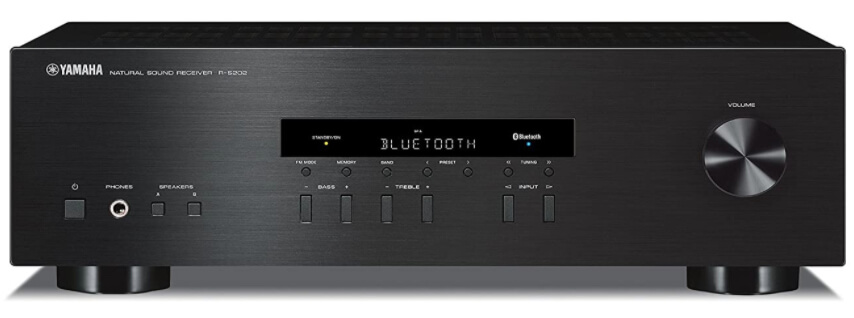
Stretch your budget and still power your speakers with solid Yamaha reliability.
3. Pioneer Elite VSX-LX104
Despite lower wattage, this multi-channel amp shines with its rich feature list. DTS Virtual:X helps with patio movies, and the integrated DAC handles optical digital sources cleanly. Powered zone 2 feeds passive speakers while main zone stays inside.
A recent firmware adds BT20A Pro-level LDAC codec. If you need multi-channel flexibility and want better sound quality than a compact Fosi Audio BT20A can offer, this Pioneer works.
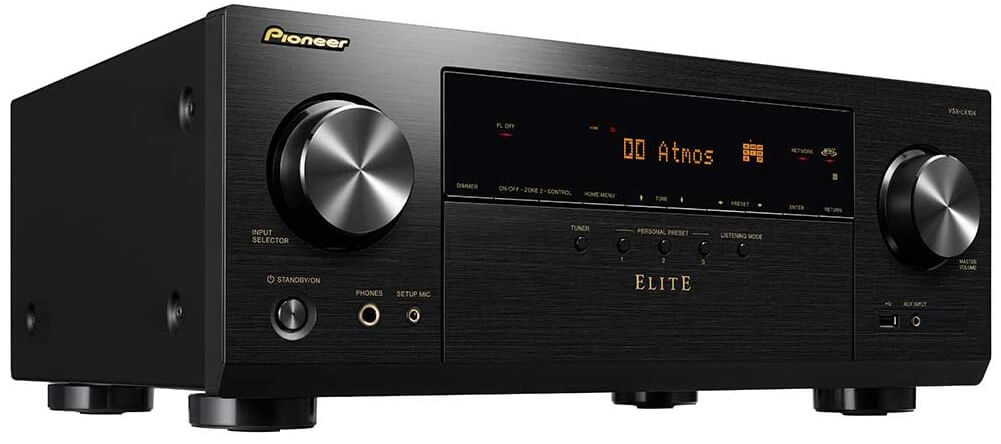
Click to load up patio speakers with Pioneer’s balanced sound.
4. Sony STR-DH190 [Best from Sony]
This stereo amplifier costs about $200 yet brings hi-fi verve. Bluetooth amplifier tech pairs fast, then you can cue classic rock on the turntable thanks to the built-in phono input.
I connected passive speakers and heard clear mids and tight lows. Add a speaker selector switch and you can send music to patio speakers or garage. It lacks WiFi, but for analog lovers it’s a gem.

Drop the needle and stream Bluetooth all from one sturdy Sony box.
5. Onkyo TX-RZ720
The TX-RZ720 hits 110 W per channel rms, so you get plenty of headroom before clipping. Chromecast lets me yell “Hey Google, play barbecue playlist” while flipping ribs.
The receiver’s AccuEQ makes setup easy; it auto-detects channels driven then adjusts bass and treble. With HDMI 2.0 and optical digital inputs you can route TV sound outdoors during game day.
Downside: old-school GUI. Still, stereo power feels clean, and LDAC Bluetooth gives better sound quality than plain SBC.
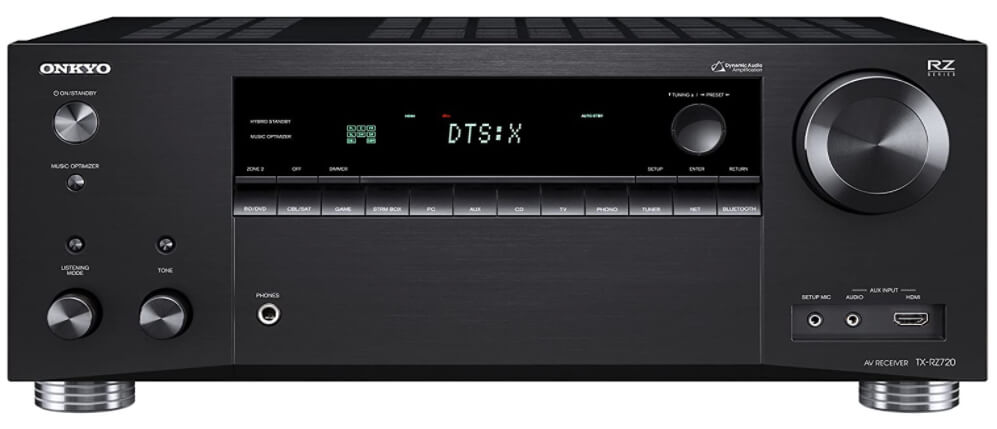
Grab this WiFi streamer and improve the sound of your patio speakers today.
6. Pioneer SX-10AE
Direct-Energy amp tech delivers good power and honest stereo sound. The codec support includes AAC for iPhone streaming.
I like the front panel’s clean layout and the sleep timer. Pair of speakers outside, FM radio for the ball game, and you’re set. Just remember, there’s no subwoofer output, so low-end punch depends on your speakers’ bass boost tolerance.
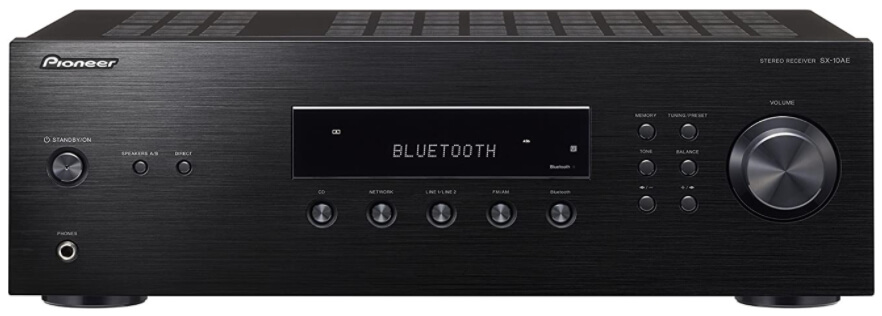
simple, rugged receiver to power patio speakers without fuss.
7. FOSI Audio BT20A Pro [Best Budget Option]
The fosi audio bt20a delivers shocking performance for just $90. This tiny amplifier pumps out 60 watts per channel into 8 ohms with the included 32V power supply. Upgrade to a 48V power supply and you get 150 watts per channel into 4 ohms. That’s enough power to drive most outdoor speakers loudly.
The TPA3255 amplifier chip provides clean, efficient Class D amplification with less than 0.005% distortion. Bluetooth 5.0 connects quickly and stays connected up to 50 feet away. I tested the bt20a pro with various outdoor speakers, and it consistently delivered clear sound without overheating.
Bass and treble controls let you tune the sound for your outdoor space. The controls have center detents, so you know when they’re flat. A pre-out connection adds a subwoofer if you want more low-end punch for outdoor parties.
The aluminum case dissipates heat well, and the compact 5×5×1 inch size means it fits anywhere. You can mount it behind speakers or tuck it into a weather-protected cabinet.
The main limitation is connectivity. You get Bluetooth and one pair of RCA inputs. No wifi streaming or multiple sources. For simple outdoor bluetooth amplifier needs, though, it’s hard to beat this value.
What to Look for in a Receiver/Amplifier for Outdoor Speakers?
Bluetooth connectivity and immersive sound technology are important considerations to have in mind when you are in the market for a receiver/amplifier sound system.
Also, just like you’d want a compact amplifier for your car, similarly, you must try to go for a receiver that doesn’t take a lot of space in your room.
However, there are other desirable features in an ideal receiver/amplifier for outdoor speakers. These attributes fall into three main categories: Physical Audio Input, Audio Streaming Functions, and Audio Output Capabilities.
Physical Audio Input
Physical Audio Input refers to the various methods in which you get to play audio content on your stereo receiver via a physical connection to the device. The majority of stereo receiver/amplifier models utilize multiple Audio Input methodologies, which include: –
AM/FM Radio
You find in-built AM/FM tuners in many home stereo receivers that allow you to scan for and save your favorite free-to-air radio stations within the 63Hz- 108Mhz FM frequency range and the 535Hz-1605kHz AM frequency range.
To access the Tuner function on your stereo receiver, you must first connect a separate FM and AM antenna to the unit.
Note that manufacturers are shifting to Tuners that only receive FM frequencies due to the declining use of the AM frequency band.
AUX/RCA Ports
Most stereo receivers allow you to directly connect CD/DVD players, phones, iPods, Mp3 Players, TVs, and other devices via AUX and RCA ports.
RCA ports are typically found at the back of the stereo system while you can often find a single AUX port at the front of the outdoor stereo system.
USB Ports
As with RCA and AUX ports, the USB port on a stereo receiver sound system allows you to connect flash storage to the device.
In this manner, you can achieve Audio Playback on your receiver/amplifier from audio and video content stored on thumb drives and external hard disks.
You can also enhance the Audio Streaming capabilities of your receiver/amplifier by connecting specialized components to the device via USB, such as the Chromecast Dongle.
SD/Micro-SD Port
Some stereo receivers even feature a TransFlash slot that allows you to realize Audio PlayBack when connecting an SD or Micro-SD card to the unit.
Mic Port
When your receiver/amplifier has a Mic Port, you can connect a microphone to the unit at the front or back and use it as a Public Address system via your outdoor speakers. This is a useful feature when holding functions outdoors.
HDMI
Some high-end receiver/amplifier models feature multiple HDMI ports that allow you to connect HDMI-enabled devices physically and, thereby, play HD Audio and Video to the outdoor sound system.
LAN
A receiver/amplifier unit that features a LAN port allows you to connect your home stereo receiver to an existing computer network.
In this manner, the stereo system becomes a shared resource in the network and, very much like a printer, you can initialize Audio Playback from any connected desktop or laptop.
Audio Streaming Functions
Audio Streaming Functions refers to a wide array of technologies that allow you to stream audio content to your receiver/amplifier unit wirelessly. These technologies include: –
Bluetooth
You can connect multiple Bluetooth devices to your receiver/amplifier if the unit features Bluetooth connectivity.
The devices you can connect include iOS and Android smartphones, tablets, laptops, and other Bluetooth-capable devices.
In this manner, you get to achieve Music Playback on your stereo receiver via dedicated audio streaming platforms such as Spotify, AirPlay, and others.
Some high-end receiver/amplifiers are even compatible with Apple CarPlay and Android Auto, allowing you to use the CarPlay and Android Auto platforms to stream audio to the device seamlessly.
WiFi
As with Bluetooth, WiFi functionality on your receiver/amplifier allows you to connect multiple devices to the unit via a localized WiFi network. You can then stream audio content to the receiver/amplifier over the WiFi network from different devices.
Audio Output Capabilities
Audio Output capabilities refer to the nature of Audio Output from your receiver/amplifier. Audio Output capabilities include: –
Surround Sound
As mentioned in the introduction, most stereo receivers support Dolby Digital and Dolby DTS surround sound technologies. This means you get to experience immersive Music Playback by utilizing a specific speaker configuration.
Amplifier Channels
The Amplifier channels of your receiver/amplifier refer to the number of speakers you can connect to the unit, with the value given in the decimal format.
The number of full-range speakers is indicated by the value in front of the decimal, while the number of sub-woofers comes after the point.
Speakers for outdoor use can be considered as full-range speakers. Other outdoor stereo features worth mentioning include Auto Speaker Calibration and Voice Command Control.
Frequently Asked Questions (FAQs)
Do you need a receiver for outdoor speakers?
If you have passive speakers which do not already come up with an inbuilt amp, you should definitely buy the receiver as it will help your speakers to perform at their full potential (max power) without any distortion.
How do I connect my outdoor speakers to my receiver?
Most outdoor speakers are compatible with any stereo receiver/amplifier. Make sure your receiver is of enough watts to power your outdoor speakers. Majority receivers/amps today have A+B channels. You can easily use the extra channel to drive exterior sound. Don’t forget to check the instruction manual of your receiver/amp for setting them up with your outdoor speakers.
How much power do I need for outdoor speakers?
Outdoor audio requires more power than indoor listening because sound dissipates in open spaces. Plan for 60-100 watts per speaker for medium outdoor areas. Large yards or pools need 100-200 watts per speaker. Factor in speaker efficiency too, since higher sensitivity speakers need less power.
Can I use any home theater receiver outdoors?
IMost home theater receivers work for powering outdoor speakers, but not all models are suitable for outdoor placement. Keep the amplifier indoors and run speaker wire outside. Look for receivers with Zone 2 outputs for independent outdoor control. Ensure your receiver can handle the impedance load of your outdoor speaker configuration.
What’s better for outdoor streaming: Bluetooth or WiFi?
Yes, a stereo receiver can be used outdoors as long as it is designed WiFi provides better sound quality and range, but bluetooth offers simpler setup and device independence. For fixed outdoor installations, wifi streaming through Chromecast or AirPlay delivers higher quality audio. Bluetooth works better for portable setups or when multiple people want to connect their devices easily.
How do I protect my amplifier from weather?
Never place amplifiers outside unless they’re specifically rated for outdoor use. Keep your amp indoors in a climate-controlled environment. Run speaker wire through weatherproof cable designed for direct burial or use conduit for protection. Some companies make weatherproof enclosures for amps, but indoor placement is always preferred.
Final Verdict: Power Your Speakers the Right Way
After testing these amplifiers extensively, the Sony STR-DN1080 emerges as the best overall choice for serious outdoor audio. Its combination of power, Zone 2 capability, and streaming features makes it ideal for expanding existing home theater systems outdoors.
For budget-conscious buyers, the FOSI Audio BT20A Pro delivers shocking performance on a budget. You won’t find better value anywhere in the amplifier market.
The key is matching your amplifier’s power output and features to your specific outdoor setup. Don’t buy more amp than you need, but don’t shortchange yourself on power either.
Ready to upgrade your outdoor audio system? Choose the amplifier that matches your space and start enjoying better sound quality outside.

